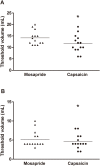Differences in the Control of Secondary Peristalsis in the Human Esophagus: Influence of the 5-HT4 Receptor versus the TRPV1 Receptor
- PMID: 27438088
- PMCID: PMC4954651
- DOI: 10.1371/journal.pone.0159452
Differences in the Control of Secondary Peristalsis in the Human Esophagus: Influence of the 5-HT4 Receptor versus the TRPV1 Receptor
Abstract
Objective: Acute administration of 5-hydroxytryptamine4 (5-HT4) receptor agonist, mosapride or esophageal infusion of the transient receptor potential vanilloid receptor-1 (TRPV1) agonist capsaicin promotes secondary peristalsis. We aimed to investigate whether acute esophageal instillation of capsaicin-containing red pepper sauce or administration of mosapride has different effects on the physiological characteristics of secondary peristalsis.
Methods: Secondary peristalsis was induced with mid-esophageal air injections in 14 healthy subjects. We compared the effects on secondary peristalsis subsequent to capsaicin-containing red pepper sauce (pure capsaicin, 0.84 mg) or 40 mg oral mosapride.
Results: The threshold volume for generating secondary peristalsis during slow air distensions was significantly decreased with capsaicin infusion compared to mosapride (11.6 ± 1.0 vs. 14.1 ± 0.8 mL, P = 0.02). The threshold volume required to produce secondary peristalsis during rapid air distension was also significantly decreased with capsaicin infusion (4.6 ± 0.5 vs. 5.2 ± 0.6 mL, P = 0.02). Secondary peristalsis was noted more frequently in response to rapid air distension after capsaicin infusion than mosapride (80% [60-100%] vs. 65% [5-100%], P = 0.04). Infusion of capsaicin or mosapride administration didn't change any parameters of primary or secondary peristalsis.
Conclusions: Esophageal infusion with capsaicin-containing red pepper sauce suspension does create greater mechanosensitivity as measured by secondary peristalsis than 5-HT4 receptor agonist mosapride. Capsaicin-sensitive afferents appear to be more involved in the sensory modulation of distension-induced secondary peristalsis.
Conflict of interest statement
Figures


Similar articles
-
Influence of repeated infusion of capsaicin-contained red pepper sauce on esophageal secondary peristalsis in humans.Neurogastroenterol Motil. 2014 Oct;26(10):1487-93. doi: 10.1111/nmo.12414. Epub 2014 Aug 14. Neurogastroenterol Motil. 2014. PMID: 25124733 Clinical Trial.
-
Effects of esophageal acid infusion vs mosapride on distension-induced secondary peristalsis in humans.Kaohsiung J Med Sci. 2019 May;35(5):310-314. doi: 10.1002/kjm2.12059. Epub 2019 Mar 21. Kaohsiung J Med Sci. 2019. PMID: 30897296 Free PMC article.
-
Effects of mosapride on esophageal secondary peristalsis in humans.Neurogastroenterol Motil. 2011 Jul;23(7):606-e249. doi: 10.1111/j.1365-2982.2011.01714.x. Epub 2011 Apr 19. Neurogastroenterol Motil. 2011. PMID: 21501334 Clinical Trial.
-
Final report on the safety assessment of capsicum annuum extract, capsicum annuum fruit extract, capsicum annuum resin, capsicum annuum fruit powder, capsicum frutescens fruit, capsicum frutescens fruit extract, capsicum frutescens resin, and capsaicin.Int J Toxicol. 2007;26 Suppl 1:3-106. doi: 10.1080/10915810601163939. Int J Toxicol. 2007. PMID: 17365137 Review.
-
Capsaicin (TRPV1 Agonist) therapy for pain relief: farewell or revival?Clin J Pain. 2008 Feb;24(2):142-54. doi: 10.1097/AJP.0b013e318158ed9e. Clin J Pain. 2008. PMID: 18209521 Review.
References
MeSH terms
Substances
LinkOut - more resources
Full Text Sources
Other Literature Sources
Medical

